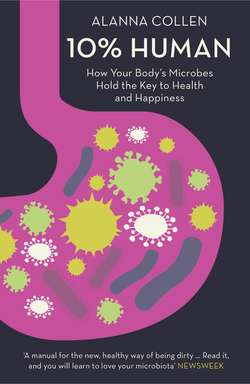Читать книгу 10% Human: How Your Body’s Microbes Hold the Key to Health and Happiness - Alanna Collen, Alanna Collen - Страница 8
INTRODUCTION The Other 90%
ОглавлениеIn May 2000, just weeks before the announcement of the first draft of the human genome, a notebook began circulating among the scientists sitting at the bar in Cold Spring Harbor Laboratory in New York State. Excitement was building about the next phase of the Human Genome Project, in which the DNA sequence would be split into its functional parts – genes. The notebook contained a sweepstake: the guesses of the best-informed group of people on the planet concerning one intriguing question: How many genes does it take to build a human?
Senior research scientist Lee Rowen, who was leading a group working on decoding chromosomes 14 and 15, sipped her beer as she pondered the question. Genes make proteins, the building blocks of life, and the sheer complexity of humans made it seem probable that the number would be high. Higher than the mouse, surely, which was known to have 23,000 genes. Probably also higher than the wheat plant, with 26,000 genes. And, no doubt, far higher than ‘The Worm’, a favourite laboratory species of developmental biologists, with its 20,500 genes.
Despite guesses averaging over 55,000 genes, and topping 150,000, Rowen’s understanding of the field meant she was inclined to go low. She placed a bet of 41,440 that year, and followed it up a year later with a second bet of just 25,947 genes. In 2003, with the true gene number only just emerging from the nearly finished sequence, Rowen was awarded the prize. Her entry was the lowest of all 165 bets, and the latest gene count had just dropped even lower than any scientist had ever predicted.
With just shy of 21,000 genes, the human genome is hardly bigger than that of The Worm (C. elegans). It is half the size of the rice plant, and even the humble water flea outstrips it, with 31,000 genes. None of these species can talk, create, or think intelligent thoughts. You might think, as the scientists entering the Genesweep pool did, that humans would have a great many more genes than grasses and worms and fleas. After all, genes make proteins, and proteins make bodies. Surely a body as complex and sophisticated as a human’s would need more proteins, and therefore more genes, than a worm’s?
But these 21,000 genes are not the only genes that run your body. We do not live alone. Each of us is a superorganism; a collective of species, living side-by-side and cooperatively running the body that sustains us all. Our own cells, though far larger in volume and weight, are outnumbered ten to one by the cells of the microbes that live in and on us. These 100 trillion microbes – known as the microbiota – are mostly bacteria: microscopic beings made of just a single cell each. Alongside the bacteria are other microbes – viruses, fungi and archaea. Viruses are so small and simple that they challenge our ideas of what even constitutes ‘life’. They depend entirely on the cells of other creatures to replicate themselves. The fungi that live on us are often yeasts; more complex than bacteria, but still small, single-celled organisms. The archaea are a group that appear to be similar to bacteria, but they are as different evolutionarily as bacteria are from plants or animals. Together, the microbes living on the human body contain 4.4 million genes – this is the microbiome: the collective genomes of the microbiota. These genes collaborate in running our bodies alongside our 21,000 human genes. By that count, you are just half a per cent human.
